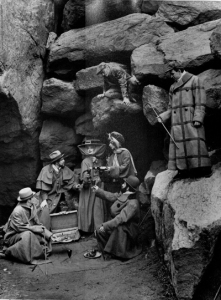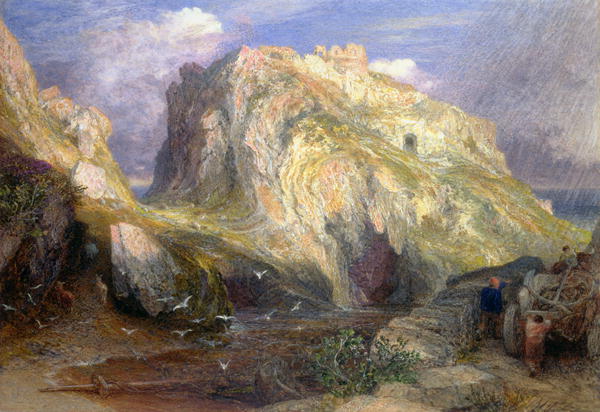Tintagel Castle and its Arthurian associations have perennial romantic appeal—but
Mary Elizabeth Braddon is the first to fictionalize a picnic on the crag, and it’s her addition to Britain’s mythology.
With lunch from a local inn, Christabel Courtnay, Angus Hamleigh, and Jessie Bridgeman sit other n castle’s “windy height,” eating chicken and salad. Still, while ladies sip sparkling water, Hamleigh drinks champagne. Harrumph!
Breathlessly chatting about the “glamour of old-world fancies” in poetry and legend enhancing the ruins that might otherwise be another pile of stones. The list of allusions is long: “To Christabel, the whole story of Arthur and his knights was as real as if it had been a part of her own life. She had Tennyson’s Arthur and Tennyson’s Lancelot in her heart of hearts and knew just enough of Sir Thomas Mallory’s prose to give substance to the Laureate’s [Tennyson’s] poetic shadows. Angus amused himself a little at her expense, as they ate their chicken and salad on the grassy mounds, which were supposed to be the graves of heroes who died before Athelstane drove the Cornish across the Tamar, and made his victorious progress through the country, even to the Scilly Isles, after defeating Howel, the last King of Cornwall.” They recite lines from Matthew Arnold’s “Tristram and Iseult” by heart.

George Platt Lynes. Picnic at Tintagel (1952), gelatin silver print. Houghton Library, Harvard College Library, Harvard University
Searching for a ballet subject, Frederick Ashton found Braddon’s reworking of Tristan and Iseult in Mount Royal. Particularly inspired by the picnic scene, Ashton used it as the framework for a lovers’ tryst titled Picnic at Tintagel (1952). More explicitly than Braddon, Ashton contrasts the timelessness of romantic lovers by splitting the action into two timeframes, one Edwardian and the Dark Ages. He chose Arnold Bax’s The Garden of Fand instead of his symphonic tone poem Tintagel. Set designed by Cecil Beaton. Photo by Lynes.
Featured Image: John William Inchbold. Tintagel (1861). Graphite and watercolor on paper. Tate Britain. Braddon never describes what her picnickers at Tintagel are looking at. But Christabel is sure it’s the real thing: “I don’t believe one word you say,” exclaimed Christabel, indignantly, “there was only one Arthur, the son of Uther and Ygerne, who was born in the castle that stood on this very cliff, on the first night of the year, and carried away in secret by Merlin, and reared in secret by Sir Anton’s wife—the brave good Arthur—the Christian king—who was killed at the battle of Camlan, near Slaughter Bridge, and was buried at Glastonbury.”
See Mary Elizabeth. Braddon. “Tintagel, Half in the Sea, and Half on Land.” In Mount Royal. London: John and Robert Maxwell, 1882.

